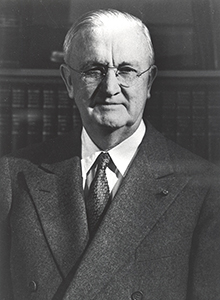
Marriner S. Eccles
- Governor, Board of Governors, 1948–1951
- Chairman, Board of Governors, 1936–1948
- Governor [Chair], Board of Governors, 1934–1936
- Born: September 9, 1890
- Died: December 18, 1977
Marriner S. Eccles was appointed chairman (called “governor” before 1935) of the Federal Reserve Board on November 15, 1934. He resigned as chairman on January 31, 1948, and remained a Board member until July 14, 1951.
Eccles was born in Logan, Utah, in 1890. After attending Brigham Young College for his high school education, he traveled to Glasgow, Scotland, in 1910 to serve a mission for the Church of Jesus Christ of Latter-Day Saints. As a child, Eccles worked in several of his father’s businesses and, after his father’s death in 1912, took over the family’s business interests. He created a family holding company, the Eccles Investment Company, in 1916 to manage the various enterprises. By the mid-1920s, Eccles, his brother George, and the Browning family controlled seventeen banks in Utah, Idaho, and Wyoming, and organized the First Security Corporation, believed to be the first multibank holding company, to manage the fifteen banks and a savings and loan institution.
Eccles briefly served as assistant to the secretary of the Treasury, Henry Morgenthau Jr., before President Roosevelt appointed him to be the chairman of the Federal Reserve.
Before entering public service, Eccles gained national attention for successfully preventing the collapse of his bank in 1931. In 1933, Congress invited him to give his analysis of the Great Depression. In his testimony, he proposed a five-point program to fix the economy that formed the basis of the New Deal.
Eccles made a lasting impact on the organization of the Federal Reserve System. Early in his tenure on the Federal Reserve Board, he pushed for the restructuring of the Fed and was instrumental in drafting the Banking Act of 1935, which gave the Board centralized authority over the System. The act made other important structural changes. In particular, the act changed the name of the Federal Reserve Board to the Board of Governors of the Federal Reserve System and eliminated the ex-officio membership of the secretary of the Treasury and the comptroller of the currency on the Board. It reduced the number of Board members to seven, all appointive, and increased their terms to fourteen years. It also changed the names of the two Board executive officers from governor and vice governor to chairman and vice chairman, respectively. Further, the act restructured the Federal Open Market Committee (FOMC) so that members of the Board made up the majority of Committee members. Previously, the twelve Reserve Bank governors had served on the Committee.
Eccles played a role in two high-profile events as well. In 1944, he was the US delegate to the Bretton Woods Conference, which established an international monetary system that included fixed exchange rates. The conference also created the World Bank and International Monetary Fund. In addition, Eccles was a key player in the dispute between the Treasury and the Fed throughout the 1940s and early 1950s.
During World War II, the Fed had committed to maintaining a low interest rate peg on government bonds. This enabled the government to finance the war more cheaply, but it also limited the Fed’s control over monetary policy and credit availability. Rate pegging continued throughout the 1940s, resulting in rising inflation. After the Korean War began in 1950, the Fed sought to end rate pegging to combat inflationary pressures. The dispute came to a head in 1951, when President Truman falsely told the press that the FOMC had agreed to support the Treasury’s interest rate peg. In response, Eccles released the FOMC minutes that showed otherwise. The incident led to the Treasury-Fed Accord in March 1951. The agreement ended the Fed’s obligation to maintain the rate peg. It also gave the Fed dominance in setting monetary and credit policies and bolstered the central bank’s independence.
After his Fed service, Eccles returned to the banking business in Utah. He died in 1977. In 1982, the Federal Reserve Building in Washington, DC, was renamed in his honor.
Written by the Board of Governors of the Federal Reserve System. See disclaimer.



